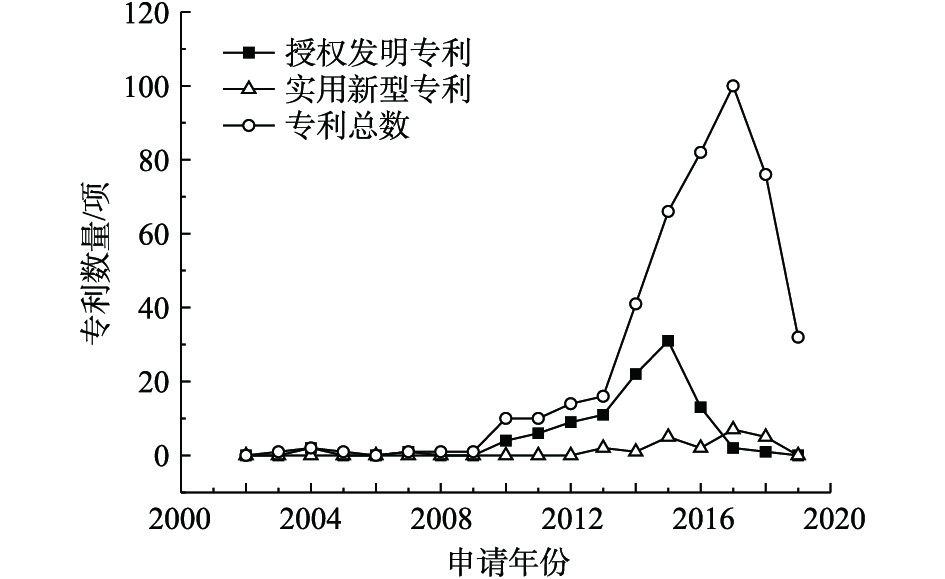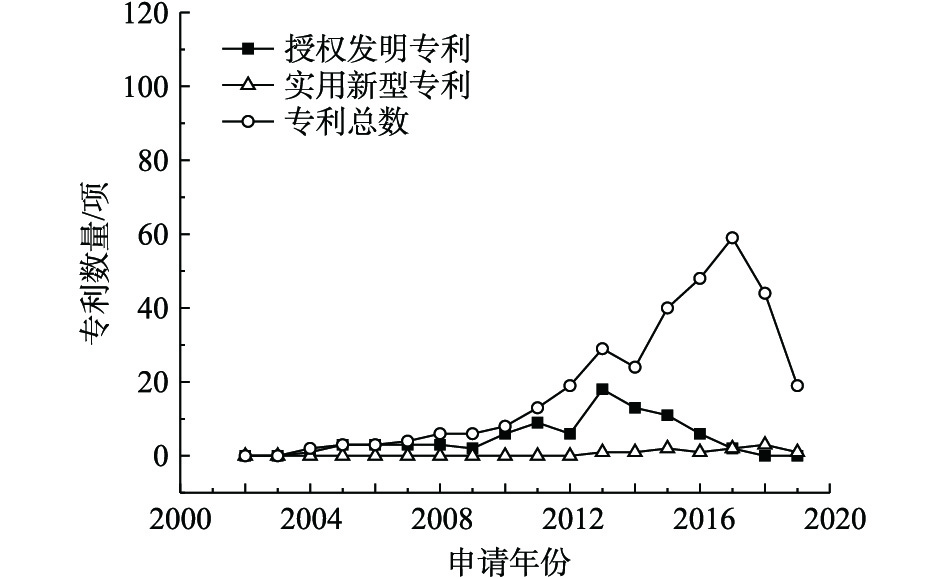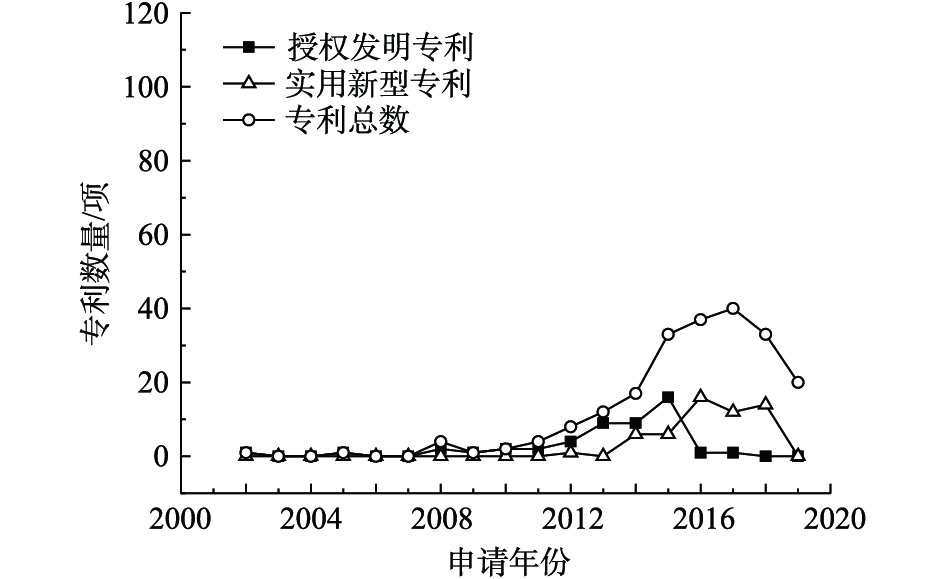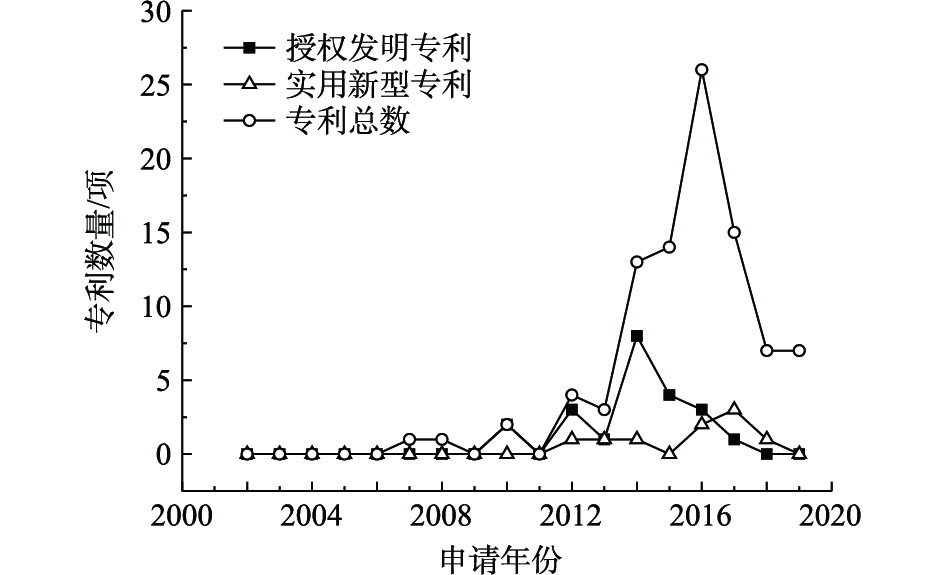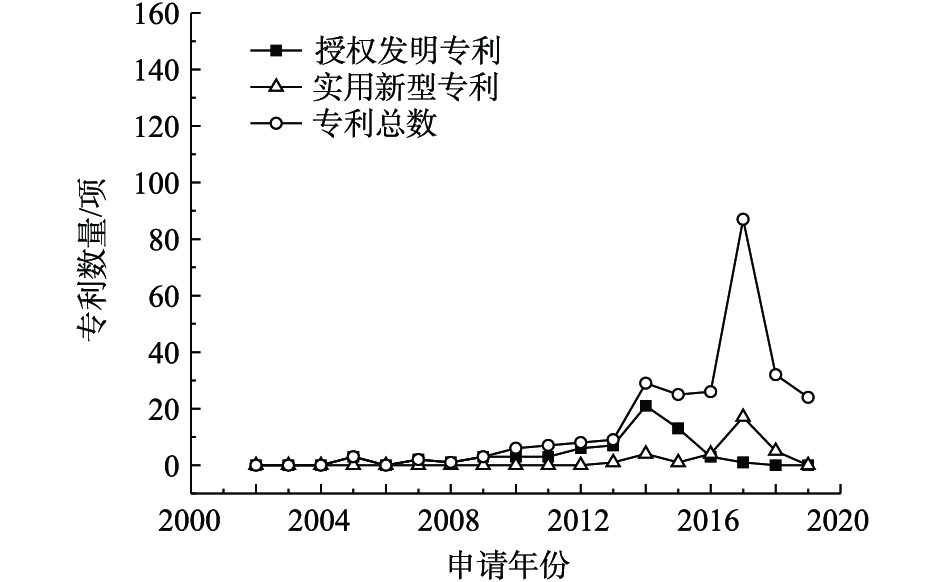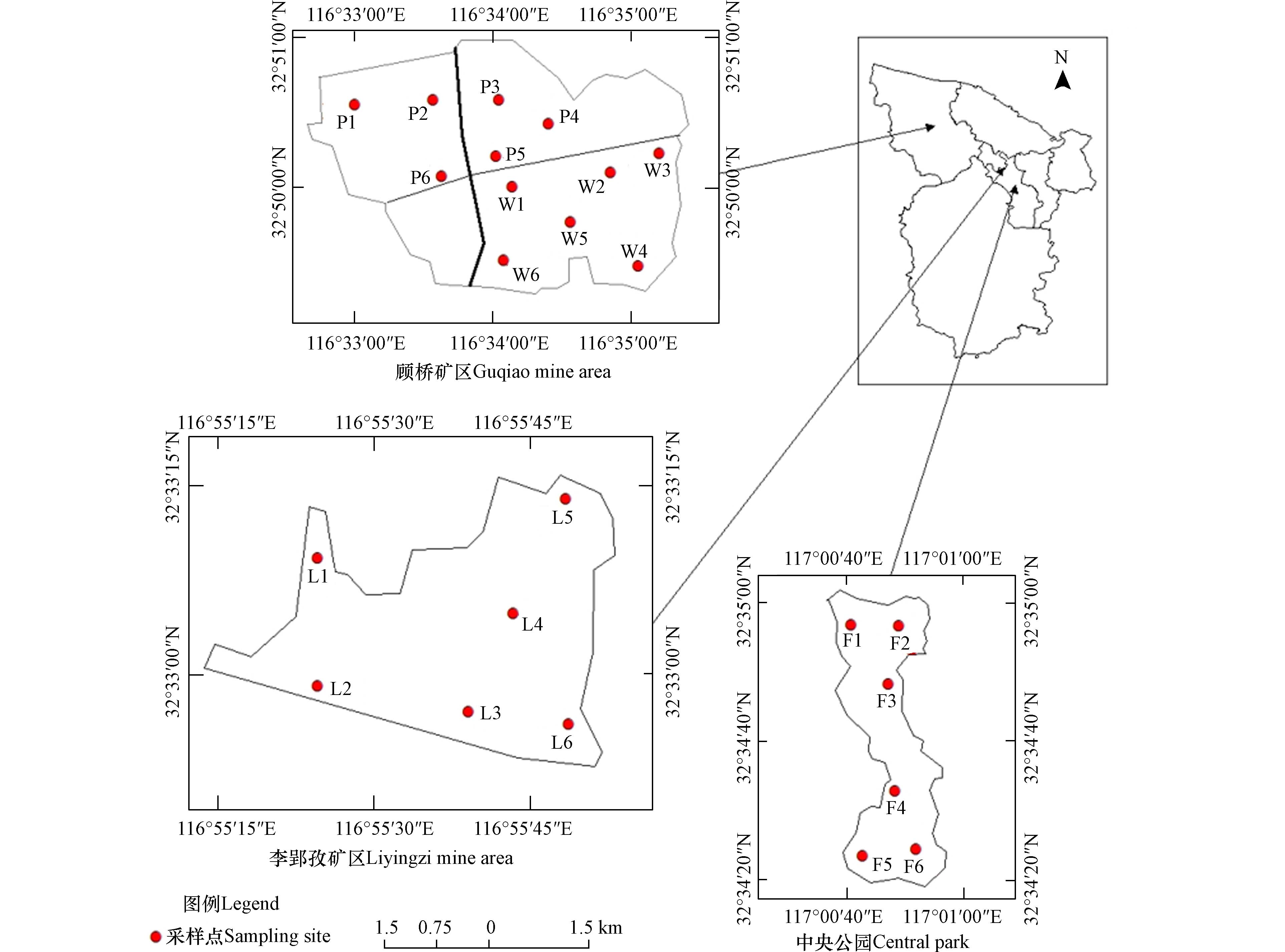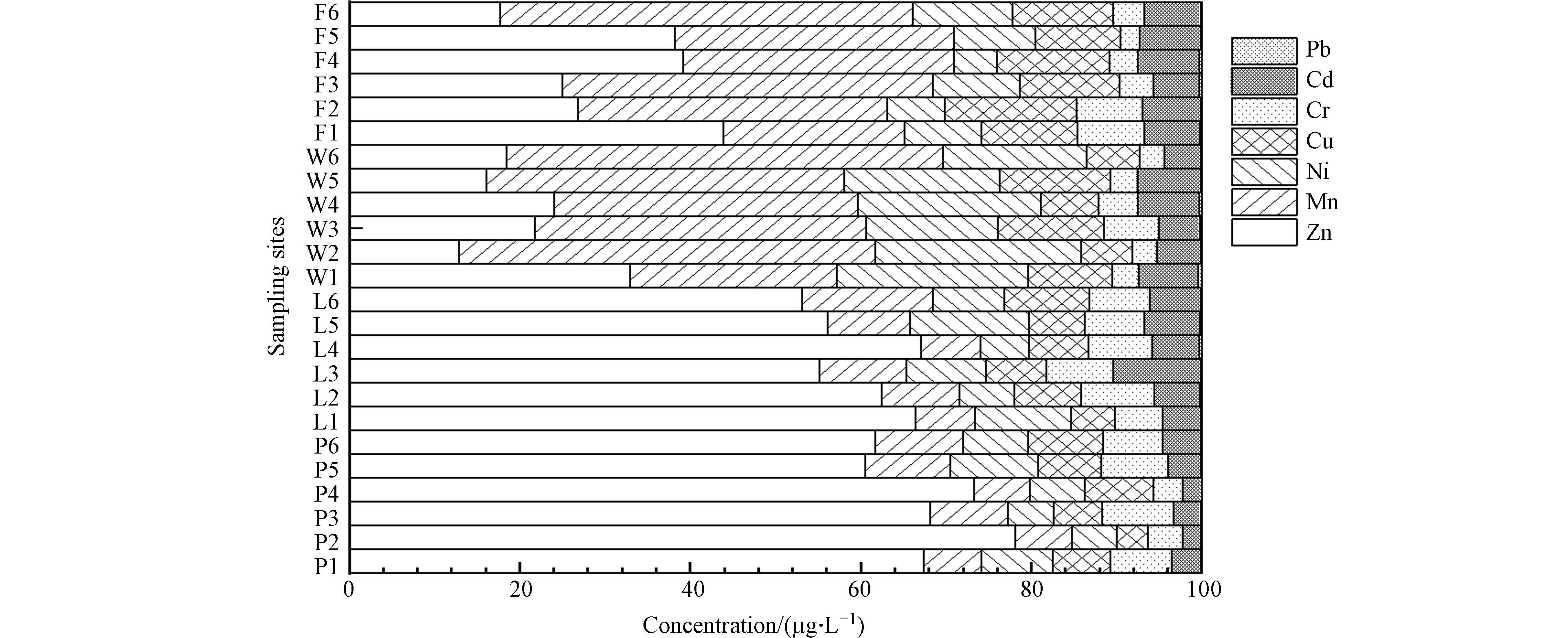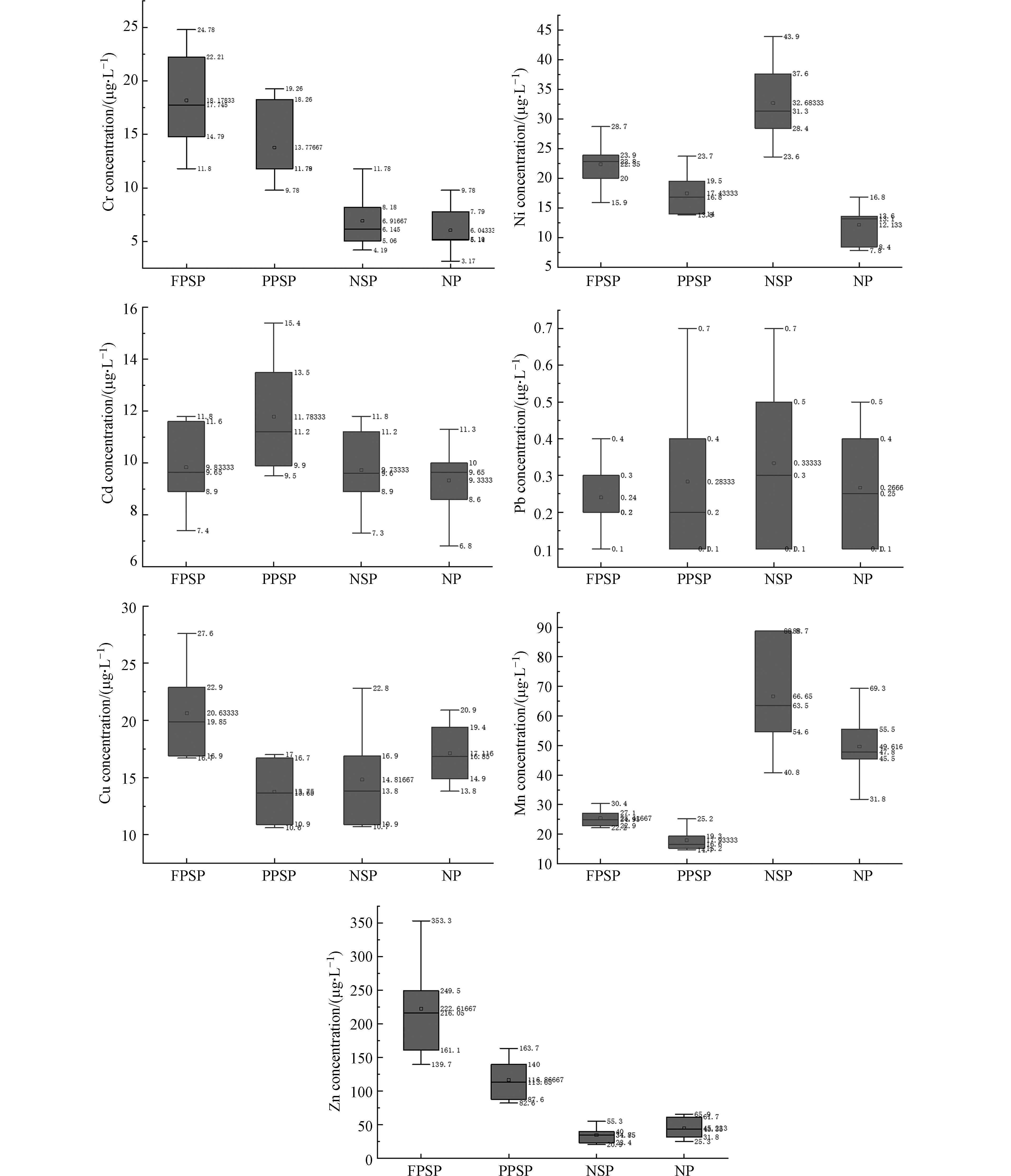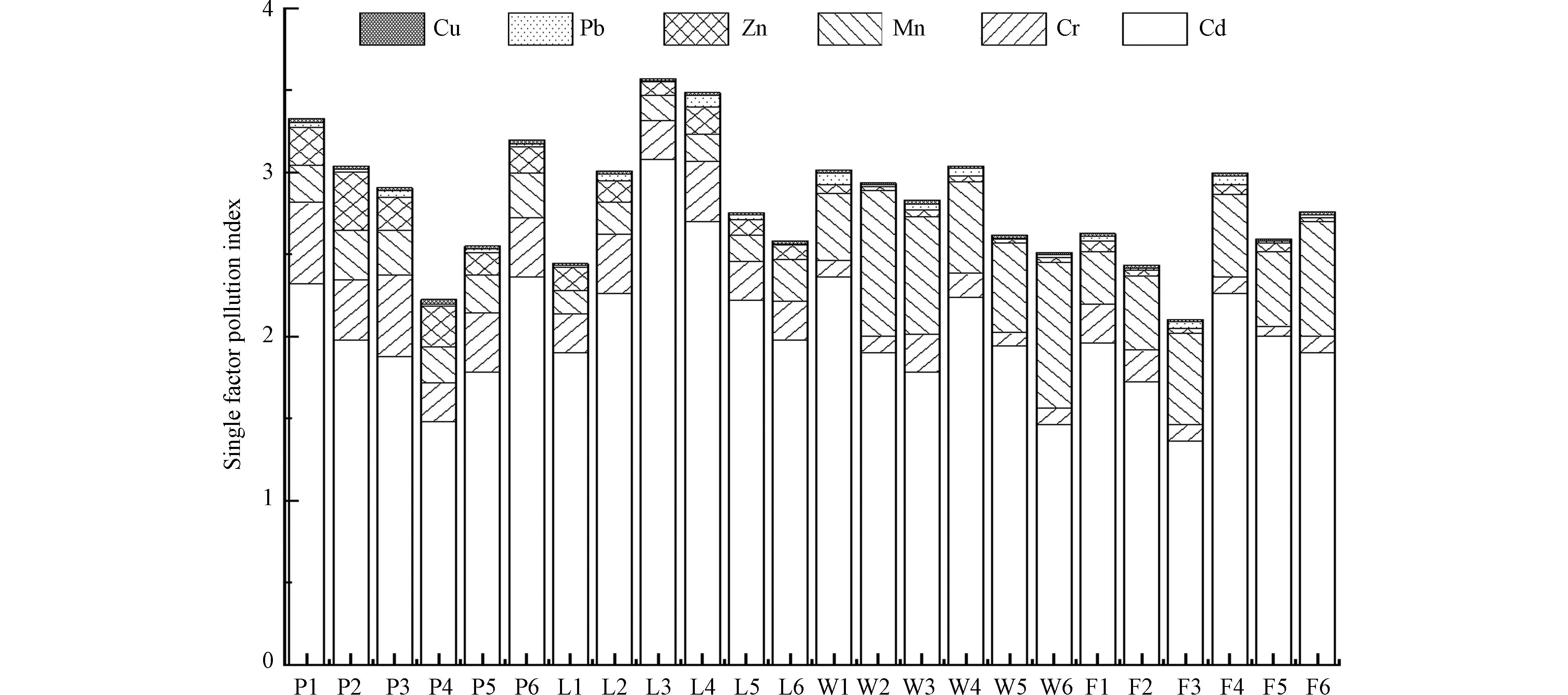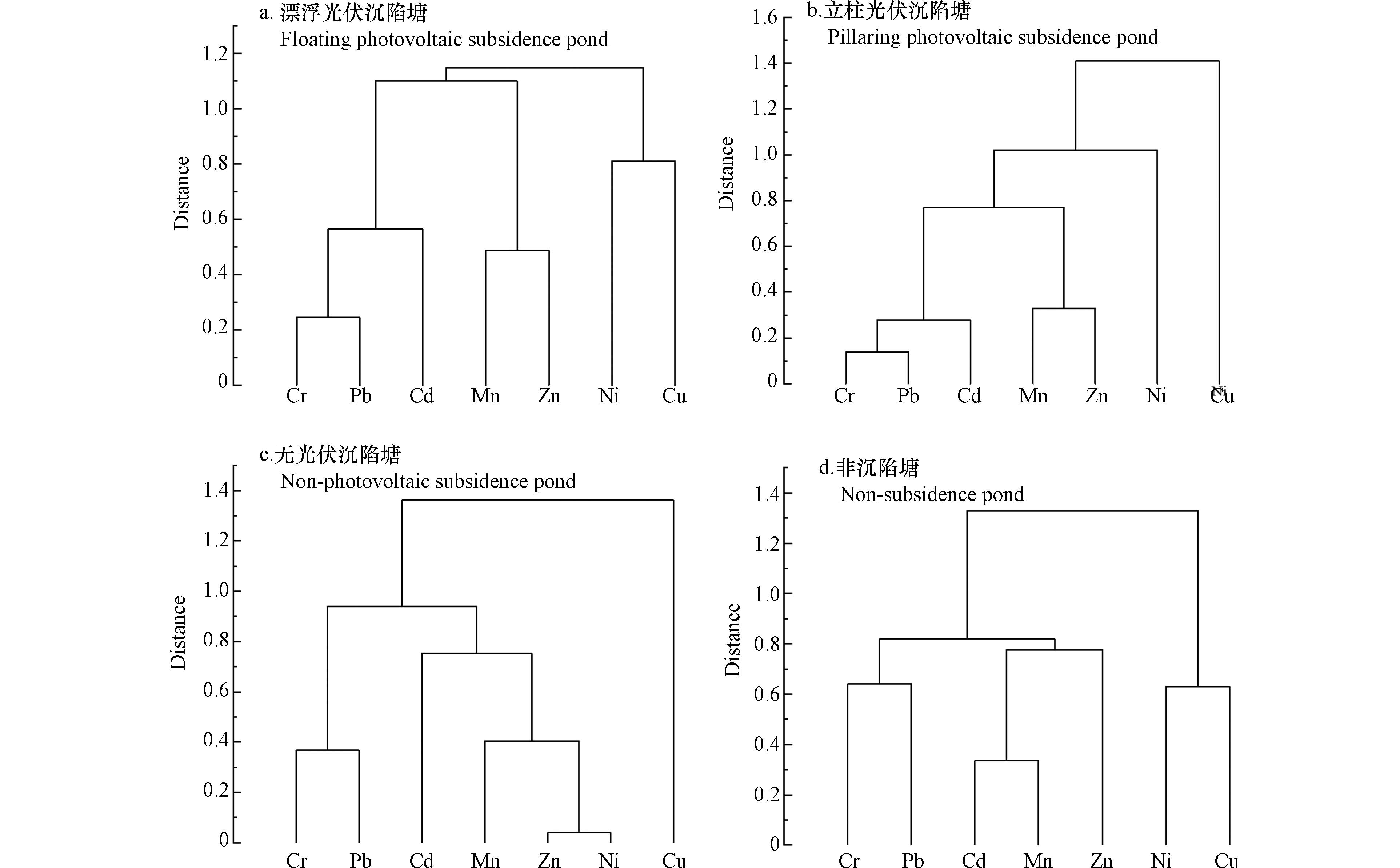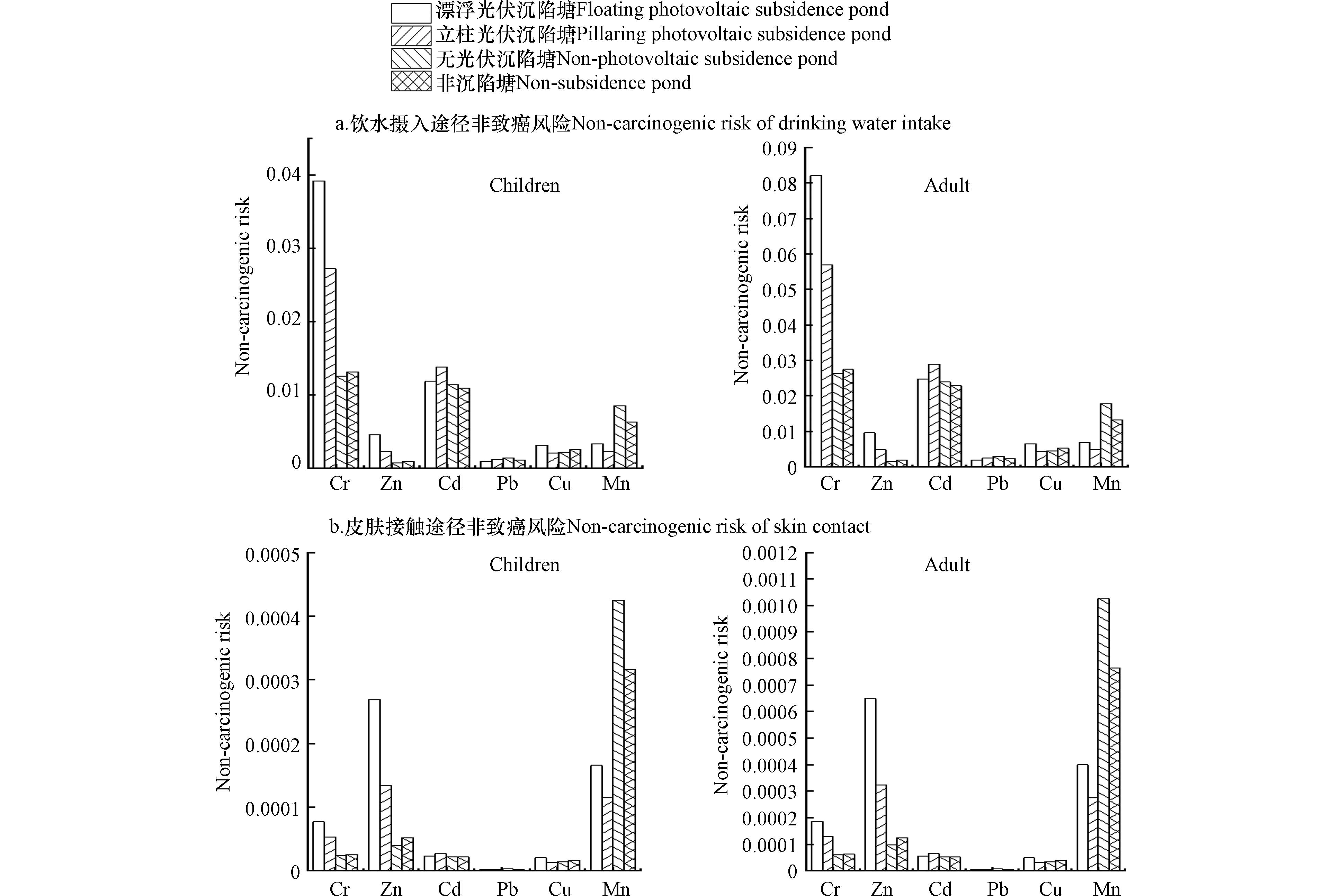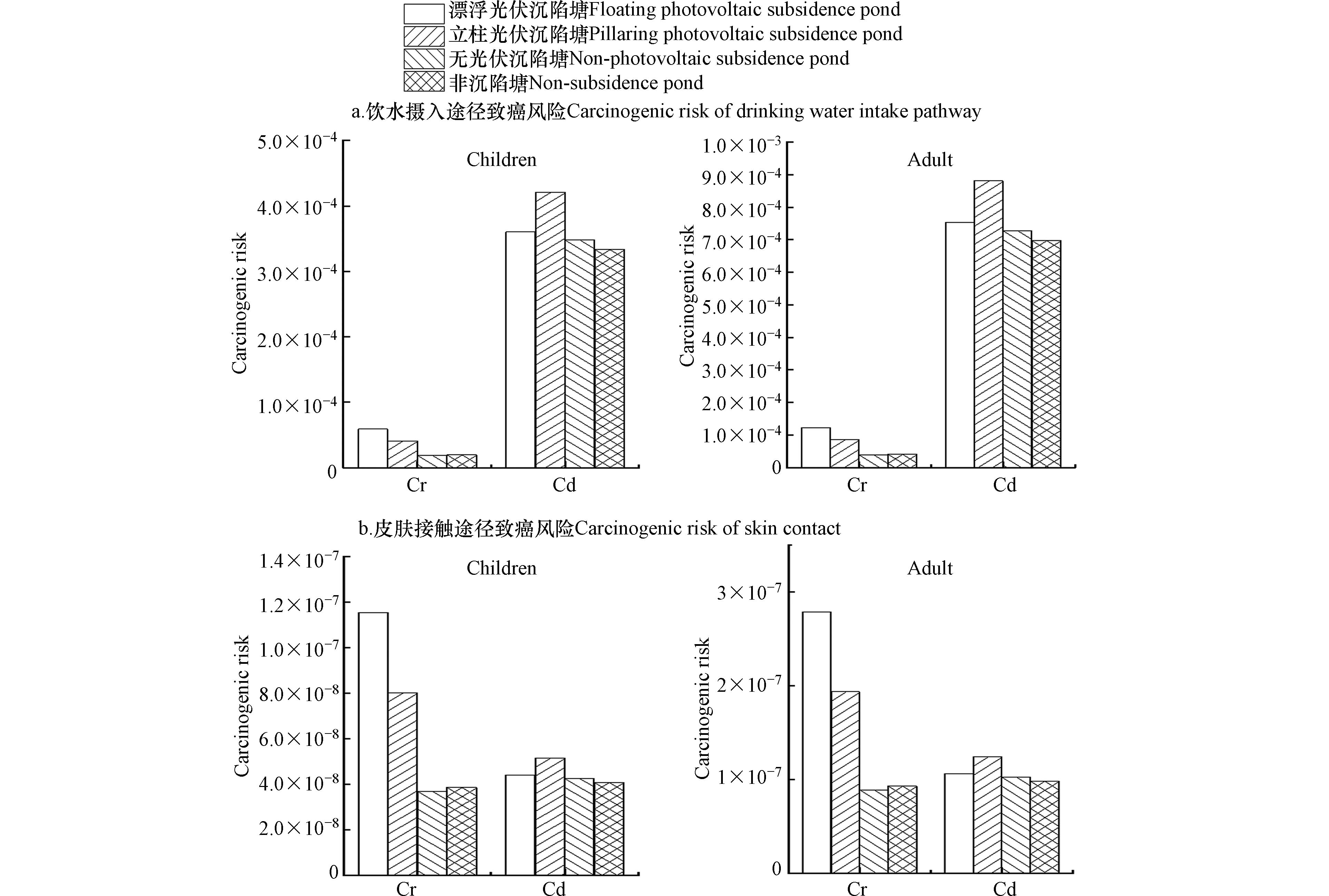-
水体中的微量元素具有难降解性和较强的生物毒性[1],对人体健康造成不可估量的损伤[2]. 随着采煤活动的不断进行,我国采煤沉陷区域面积逐年递增[3],开采所产生的副产物释放微量元素进入沉陷水体中,对采煤沉陷区的水体及土壤造成严重的生态威胁[4]. 近年来,不少研究发现,采煤沉陷塘出现了微量元素富集现象,如刘旭[5]发现淮南沉陷水体的重金属受煤矸石堆积、公路干道等人为因素影响,导致沉陷塘水体部分点位出现重金属富集现象. 此外,任永乐等[6]发现淮南沉陷塘水体微量元素Cd、Pb、Cu、Ni富集,陈同等[7]对研究发现,淮南潘集采煤沉陷水体底泥中微量元素Cu、Zn、Cd 富集,其中Cd富集程度最高. 以上研究表明,采煤沉陷塘出现了Cd、Pb、Cu、Ni、Zn元素富集,同时,Cd元素在稳沉、非稳沉沉陷塘富集,且富集程度较高.
然而,近年来,不少沉陷塘上铺设了太阳能光伏面板,包括漂浮型和立柱型两大类,如2017年淮南市潘集
6000 亩采煤沉陷水域上建设的漂浮型光伏电站和李郢孜采煤沉陷水域的立柱型光伏电站. 国际上少数研究表明,光伏电站的建设对水生态环境的影响并不大[8 − 9],甚至从长远看可以实现良性向好发展,但也有研究表明光伏电站的建设降低了沉水植物对浮游植物的竞争力,导致浮游植物生物量的增加和沉水植物量的减少,进而使整个水生态环境恶化[10]. 因此,探究不同类型光伏面板是否对采煤沉陷水域微量元存在不利影响势在必行.对采煤沉陷塘微量元素的含量特征、形态分布和风险评估等方面进行研究的主要方法包括单因子污染指数法[11]、综合污染指数法[12]、内梅罗指数法[13]、相关性分析[14]、主成分分析[15 − 16]和健康风险评价法[17],这些方法对水体微量元素的研究发展具有重要意义. 目前学界对采煤沉陷塘的研究主要集中在微量元素时空变化特征及健康风险评价、来源分析以及水体理化性质和微量元素的相关性分析[15, 17 − 18],对采煤沉陷塘和非沉陷塘微量元素分布特征的研究很少. 因此本研究选取淮南矿区光伏沉陷塘、和无光伏沉陷塘作为研究对象,以淮南市中央公园湖泊(非沉陷塘)作为对照区,分析沉陷塘水体中Cr、Ni、Cd、Pb、Cu、Mn、Zn的浓度分布特征,并运用内梅罗指数法、健康风险评价模型、相关性和聚类分析对水体微量元素进行评价,以期为沉陷塘光伏项目的发展、采煤沉陷塘的综合治理和居民饮水和用水安全提供科学依据.
-
淮南矿区位于安徽省北部的淮河两岸,位置属华北板块南缘,东起郯庐断裂带,西至阜阳断层,北接蚌埠隆起,南以老人仓-寿县断层与合肥坳陷相邻,由老矿区(谢家集区)和新矿区(潘谢矿区)组成,面积约
3200 km2[19],是我国14个大型煤炭基地和6大煤电基地之一,不但煤种丰富,且资源保有量为324亿吨,是国家煤炭资源开采与利用的重大工程建设区[20]. 随着煤炭资源的不断开采,矿区沉陷区域面积逐年递增,目前已超300 km2.研究区域年均气温为15. 5 ℃,年均降水量为900.1 mm,年均蒸发量为747.0 mm. 区域内四季分明,全年主导风向为东南风和东北风,降雨主要集中在夏季,秋冬季节干燥寒冷,降雨量少[21].
-
选取顾桥矿区的漂浮光伏沉陷塘和无光伏沉陷塘、李郢孜矿区的立柱光伏沉陷塘作为研究水域,淮南矿区光伏电站于2017年至2018年期间建设完成,淮南中央公园位于淮南市高新区,北邻政务中心,南邻奥林匹克公园,总面积约
900000 m2,中心湖面面积达420000 m2,周边建设尚未完成,仍然保持苗圃林地原生状态,受污染程度小,因此,为排除部分外部因素影响,选取淮南市中央公园非沉陷塘水样作为对照,于2021年6月进行船只采样.依照《水和废水监测分析方法(第4版)》,在沉陷塘和中央公园非沉陷塘上分别设置6个采样点(漂浮光伏沉陷塘采样点编号为P1—P6,立柱光伏沉陷塘采样点编号为L1—L6,无光伏沉陷塘采样点编号为W1—W6,中央公园非沉陷塘采样点编号为F1—F6),采样点尽可能均匀分布在整个采样空间内,在采样点水面下0.5 m处采集多点混合瞬时水样500 mL,现场加入硝酸酸化,4 ℃保存,带回实验室持续低温保存,采样点具体位置分布如图1所示.
水样用0.45 μm醋酸纤维素滤膜过滤,采用《水质重金属总量消解硝酸法(HJ677—2013)》进行消解,利用电感耦合等离子体质谱仪(ICP-MS,NexION300X)测定Cr、Ni、Cd、Pb、Cu、Mn、Zn含量,并实行质控控制,试验设置1个空白样和3个平行样.
-
采用单因子污染指数(Pi)和内梅罗指数(Ni)综合评价地下水中重金属污染水平,公式如(1—2).
式中,i为不同重金属,ci为水中重金属实测浓度,si为地表水质量标准(GB3838—2002)的Ⅲ类浓度阈值,ci、si单位为μg·L−1,其划分标准如表1.
-
微量致癌物可能对人体健康产生危害,非致癌物(又称为躯体毒物质)对人体健康产生的危害也不容忽视,其危害主要表现在对人体器官或系统的危害. 因此对采煤沉陷塘水体致癌物质和非致癌物质都应该进行健康风险评价.
人体健康风险模型(HHR)以风险度为评价指标,将环境污染与人体健康结合,定量描述环境污染对人体健康的危害. 根据EPA标准,环境介质中的有毒金属可通过饮水摄入、皮肤接触和口鼻吸入三种暴露途径危害人体健康,并成人和儿童两种暴露人群分开考虑. 根据沉陷塘水体特点,仅考虑饮水摄入和皮肤接触暴露途径造成的健康风险[22].
非致癌物质的暴露量通常用日均暴露剂量表征,致癌物质的暴露量通常用终生日均暴露剂量表征. 饮水摄入途径暴露的健康风险计算公式如(3—5):
皮肤接触途径暴露的健康风险计算公式如(6—8):
非致癌物风险值公式如(9):
健康风险评价模型参数如表2所示.
RfD为微量元素直接摄入的参考剂量[mg·(kg·d)−1];SF为直接摄入暴露的致癌系数[mg·(kg·d)−1],具体参数详见表3.
-
运用SPSS27对数据进行平均值、标准差、Pearson相关性分析和聚类分析,采用Origin2021进行图形绘制.
-
由图2、表4可知,漂浮光伏沉陷塘中微量元素浓度从大到小排序为:Zn>Mn>Ni>Cu>Cr>Cd>Pb,其中Cd浓度为19.35 μg·L−1,是《地表水环境质量标准》(GB3838-2002)Ⅲ类水环境质量标准1.97倍,其他微量元素浓度均小于Ⅲ类水环境质量标准,立柱光伏沉陷塘中微量元素浓度从大到小排序为:Zn>Mn>Ni>Cr>Cu> Cd>Pb,其中Cd浓度为13.94 μg·L−1,是Ⅲ类水环境质量标准2.36倍,其他微量元素浓度均小于Ⅲ类水环境质量标准,无光伏沉陷塘中微量元素浓度从大到小排序为:Mn>Zn>Ni>Cu>Cd>Cr>Pb,其中Cd浓度为6.42 μg·L−1,是Ⅲ类水环境质量标准1.95倍,其他微量元素浓度均小于Ⅲ类水环境质量标准,非沉陷塘中微量元素浓度从大到小排序为:Mn>Zn>Cu>Ni> Cd>Cr>Pb,其中Cd浓度为6.71 μg·L−1,是Ⅲ类水环境质量标准1.87倍,其他微量元素浓度均小于Ⅲ类水环境质量标准,淮南矿区沉陷塘Cd浓度是皖北某矿区沉陷水体的4.44—5.60倍. 整体上看,Cd富集程度从大到小排序为:立柱光伏沉陷塘>漂浮光伏沉陷塘>无光伏沉陷塘>非沉陷塘.
与长江河源区作为未受人类活动影响的背景区水丰度[25]相比,淮南矿区沉陷塘和中央公园非沉陷塘微量元素Cd、Cu、Zn呈现富集现象,其中漂浮光伏沉陷塘、立柱光伏沉陷塘、无光伏沉陷塘和中央公园非沉陷塘Zn浓度分别为222.62 μg·L−1、116.87 μg·L−1、34.85 μg·L−1、45.23 μg·L−1,是长江河源区背景值的5—37倍,是皖北某矿区沉陷水体的0.69—4.40倍,Zn的浓度从大到小的排序为:漂浮光伏沉陷塘>立柱光伏沉陷塘>非沉陷塘>无光伏沉陷塘.
前人研究可知,Cu、Zn可能与地区地质条件、矿产资源开采等人为因素有关[26],Cu、Zn浓度较高并不能说明微量元素Cu、Zn对水体造成了污染,因为Cu、Zn是正常生理代谢所必须的微量元素,只有当微量元素超过生物所必须的量时,才能对生物体产生毒性效应[27],所以Cu、Zn浓度是否对生态环境造成损害,还需进一步分析. 此外,经实地调查发现,淮南矿区沉陷塘出现Cd富集现象是由于多年煤炭开采、煤矸石经雨水淋溶进入沉陷水体导致的.
-
由图3可知,淮南矿区不同沉陷塘Cr、Ni、Mn、Zn等4种微量元素分布特征较明显,其中Cr、Zn的浓度分布特征表现为:漂浮光伏沉陷塘>立柱光伏沉陷塘>非沉陷塘、无光伏沉陷塘,Ni、Mn浓度分布存在差异,Ni表现为:无光伏沉陷塘>漂浮光伏沉陷塘、立柱光伏沉陷塘>非沉陷塘,Mn表现为:无光伏沉陷塘、非沉陷塘>漂浮沉陷塘沉陷塘>立柱光伏沉陷塘.
整体上看,沉陷塘Ni浓度高于非沉陷塘,其他元素无明显差别;光伏沉陷塘Cr、Zn浓度高于无光伏沉陷塘,但Mn浓度却低于无光伏沉陷塘,其他元素无明显差别;漂浮型光伏沉陷塘Cr、Mn、Zn浓度明显高于立柱型光伏沉陷塘,但Cd浓度却低于立柱型光伏沉陷塘,其他元素无明显差别.
综上,有、无光伏面板覆盖水域的微量元素浓度没有明显差别,表明淮南矿区沉陷塘水体本身微量元素浓度很低,且没有受到光伏面板FPV材料的污染,这与宋鑫[9]等的研究结果一致,宋鑫等通过监测沉陷塘高光伏覆盖率、低光伏覆盖率和无光伏覆盖率的沉陷塘重金属浓度,没有发现高覆盖率的光伏板浸泡导致水域重金属浓度升高的迹象. 此外,不同类型光伏电站的建设可能会导致沉陷塘中微量元素Cr、Mn、Zn呈现明显浓度差异,其大小顺序为:漂浮型光伏电站>立柱型光伏电站设置立柱光伏电站的沉陷塘水深较浅,适合最高洪水位时应小于5 m的水域,漂浮型光伏电站适合最高洪水位大于5 m且最低枯水位大于1 m的水域,因此,立柱型光伏沉陷塘Cr、Mn、Zn浓度较低可能是由于立柱型光伏面板一般用于水深较浅的水体中,较浅水体悬浮物沉降速率较高,内源性污染较低[16].
-
由图4可知,漂浮光伏沉陷塘微量元素单因子污染指数Pi在0.01—2.36之间,平均值约为0.48,立柱光伏沉陷塘微量元素Pi在0.01—3.08之间,平均值约为0.50,无光伏沉陷塘微量元素Pi在0.01—2.36之间,平均值约为0.47,非沉陷塘Pi在0.01—2.00之间,平均值约为0.43,根据单因子污染指数分类标准,沉陷塘与非沉陷塘的污染因子均为Cd,漂浮光伏沉陷塘和立柱光伏沉陷塘无明显差别,整体上看,光伏沉陷塘PCr、PZn>非光伏沉陷塘PCr、PZn,光伏沉陷塘PMn<非光伏沉陷塘PMn.
由表5可知,各微量元素内梅罗污染指数大小排序为Cd>Cr>Zn>Mn>Pb>Cu,根据内梅罗污染水平分类标准,立柱光伏沉陷塘的重金属Cd的污染水平处于中度污染,漂浮光伏沉陷塘、无光伏沉陷塘和非沉陷塘的Cd处于轻度污染水平,其他元素均处于清洁水平. 整体上看,光伏沉陷塘NCr、NZn>非光伏沉陷塘NCr、NZn,光伏沉陷塘NMn<非光伏沉陷塘NMn,与单因子污染指数发评价结果一致,从污染程度上看,本研究中的无光伏沉陷经过多年综合治理,污染程度与淮南中央公园非沉陷塘相差无几.
综上,淮南矿区沉陷塘的污染因子为Cd,微量元素污染指数平均值从大到小的顺序为:立柱型光伏沉陷塘>无光伏沉陷塘>漂浮型光伏沉陷塘>非沉陷塘.
-
为分析淮南矿区沉陷塘和中央公园非沉陷塘中的7种微量元素的相关关系,计算了pearson相关系数,结果如表6所示,漂浮光伏沉陷塘和立柱光伏沉陷塘水体微量元素Cr-Pb呈显著正相关,相关系数分别为0.944、0.860,表明随着Cr和Pb的污染来源相同[32]. 无光伏沉陷塘中Mn-Cd显著负相关,相关系数为−0.829,Zn-Pb极显著正相关,相关系数为0.961. 淮南矿区沉陷塘微量元素之间存在显著或极显著的相关性,表明这些元素之间可能存在复合污染或者同源关系[33].
为进一步探求淮南矿区沉陷塘中Cr、Ni、Cd、Pb、Cu、Mn、Zn的来源,分别对每个沉陷塘的微量元素进行聚类分析. 由图5可以看出,可将漂浮光伏沉陷中的Cr、Ni、Cd、Pb、Cu、Mn、Zn归为3类,第一类元素为Cr、Cd、Pb,第二类元素为Mn、Zn,第三类元素为Ni、Cu,有研究表明,Pb、Cd可能来源于冶炼化工行业(如铅蓄电池)生产过程中产生废水和固体废物[34],也可能是燃煤产生的,Cr主要源于冶炼化工、矿业开采等人为活动[35],Cu、Zn来源于农药、有机肥、化肥、畜禽粪便,Ni、Cu、Zn可能来源于工业源和交通源[36],Mn来源于道路降尘、采矿扬尘和建筑扬尘,此外,地表水中Mn不易被氧化,因此可能来源于内源性污染[37],Zn来源于汽车排放,Pb也可能来自交通和工业垃圾堆肥等[38],Cd可能来自燃煤、施肥过程. 综上,漂浮光伏沉陷塘的污染源为冶金化工、汽车排放.
立柱光伏沉陷塘中微量元素可分为4类,第一类元素是Cr、Pb、Zn,第二类元素是Cu、Mn,第三类元素是Cd,第四类元素是Ni,根据本研究相关性和聚类分析,可推测立柱光伏沉陷塘的污染源为矿业开采、道路交通、燃煤和农业肥料;无光伏沉陷塘中微量元素可分为3类,第一类元素是Cr、Cu,第二类元素是Ni、Cd、Pb、Zn,第三类元素是Mn,可推测无光伏沉陷塘的污染源为工业生产、交通运输和内源污染;非沉陷塘中的微量元素可归为3类,第一类元素为Cr、Cu,第二类元素为Cd、Pb、Zn,第三类元素为Ni、Mn,可推测非沉陷塘的污染源为工业生产、农业肥料和道路交通.
-
由图6所示,淮南矿区沉陷塘非致癌物质Cr、Cd、Mn、Cu、Zn、Pb对成人和儿童的非致癌风险变化趋势一致,饮水摄入途径下为:Cr>Cd>Mn>Cu>Zn>Pb,对成人的平均风险值在1.42×10−3—8.21×10−2之间,对儿童的平均风险值在6.80×10−4—3.92×10−2之间;皮肤接触途径下,非致癌物质对成人和儿童的平均风险值变化趋势为Mn>Zn>Cr>Cd>Cu>Pb,对成人的风险值在4.30×10−6—1.03×10−3之间,对儿童的风险值在1.78×10−6—4.25×10−4之间. 由此,饮水摄入途径和皮肤接触途径下微量元素对成人和儿童的非致癌风险值均处于可接受水平,整体表现为成人>儿童,且饮水摄入途径>皮肤接触途径. 两种途径的非致癌总风险值如表7所示,漂浮光伏沉陷塘、立柱光伏沉陷塘、无光伏沉陷塘和非沉陷塘微量元素对成人和儿童的非致癌总风险HI小于1,均处于人体可接受水平. 整体上看,微量元素对成人和儿童的非致癌总风险值表现为:漂浮光伏沉陷塘>立柱光伏沉陷塘>无光伏沉陷塘>非沉陷塘.
由图7可知,致癌物Cr、Cd的致癌风险值CR通过饮水摄入途径和皮肤接触途径暴露的健康风险变化规律与非致癌健康风险一致,整体表现为:成人>儿童,这与程晓静[15]、师环环[24]等的研究结果一致,说明虽然儿童对重金属的敏感性高于成人,但其饮水量、暴露时间和体重相对成人较少,因此非致癌风险值较低[22, 39],此外,致癌风险值均表现为Cd>Cr. 根据USEPA公布的分类标准,淮南矿区沉陷塘和对照区非沉陷塘中致癌物质Cr、Cd对儿童和成人的致癌风险CR低于1×10−6,认为无致癌风险或致癌风险较低.
-
完整的健康风险评估应包括饮水摄入、口鼻吸入和皮肤接触的途径吸入空气、土壤和水中的污染物造成的健康风险[40]. 本研究仅通过饮水摄入途径对研究区沉陷塘和非沉陷塘的Cr、Cd进行健康风险评价,暴露途径和暴露浓度可能因所处环境的改变随时间发生变化,且采样区域和统计模型本身具有局限性,健康风险模型的参数选择也存在不确定性,并不能准确反映研究区健康风险现状[41]. 此外,考虑到该矿区居民的流动性,暴露在沉陷塘中的人群在时间、生活方式、体重、体质等方面存在差异[13],并且考虑到本研究采集的样品数较少,目前的评估结果应被视为初步评估.
-
1)淮南矿区沉陷塘中Cd超出《中国地表水环境质量标准》(GB3838-2002)中Ⅲ类水环境质量标准,Cd、Cu、Zn明显大于长江河源区背景值,呈现一定富集现象,其中Zn富集程度最高.
2)浓度分布特征表明沉陷塘微量元素浓度较低,没有受到光伏面板材料的影响或光伏面板影响较小,且不同类型光伏电站的建设可能会导致沉陷塘中微量元素Cr、Mn、Zn呈现明显浓度差异,一般表现为:漂浮型光伏电站>立柱型光伏电站.
3)立柱光伏沉陷塘污染水平较高,污染因子为Cd,污染水平整体表现为:立柱光伏沉陷塘>漂浮光伏沉陷塘,光伏沉陷塘>无光伏沉陷塘,沉陷塘>非沉陷塘.
4)相关性和聚类分析显示,漂浮光伏沉陷塘的污染源为冶金化工、汽车排放,立柱光伏沉陷塘的污染源为矿业开采、道路交通、燃煤和农业肥料,无光伏沉陷塘的污染源为工业生产、交通运输和内源污染,非沉陷塘的污染源为工业生产、农业肥料和道路交通.
5)沉陷塘中非致癌物质通过饮水摄入途径和皮肤接触途径对成人和儿童造成的非致癌总风险HI小于1,处于人体可接受水平,致癌物质Cr、Cd对儿童和成人的致癌风险CR低于1×10−6,认为无致癌风险或致癌风险较低.
淮南光伏沉陷塘微量元素变化特征及健康风险评价
Study on the variation characteristics and health risk assessment of trace elements in photovoltaic subsidence ponds in Huainan
-
摘要: 为探究沉陷塘与非沉陷塘、光伏沉陷塘与无光伏沉陷塘、漂浮型光伏沉陷塘与立柱型光伏沉陷塘微量元素污染特征和健康风险的差异,本研究选取对光伏沉陷塘中Cr、Ni、Cd、Pb、Cu、Mn、Zn等7种微量元素进行测试分析,利用相关性和聚类分析,并采用单因子污染指数法、内梅罗指数法和USEPA模型对微量元素进行风险评价. 结果表明,沉陷塘中Cd大于《中国地表水环境质量标准》(GB3838-2002)中Ⅲ类水环境质量标准,最高达11.78 μg·L−1,Cu、Zn浓度最小值分别为13.75 μg·L−1、34.85 μg·L−1,均大于长江河源区背景值3.01 μg·L−1、6.46 μg·L−1,呈现一定富集现象,其中,Zn富集程度较高;与无光伏沉陷塘相比,沉陷塘微量元素浓度较低,没有受到光伏面板材料的影响或光伏面板影响较小,整体表现为漂浮型光伏电站>立柱型光伏电站>无光伏沉陷塘;单因子指数法和内梅罗指数法发现沉陷塘污染水平整体表现为立柱光伏沉陷塘>漂浮光伏沉陷塘,光伏沉陷塘>无光伏沉陷塘,沉陷塘>非沉陷塘;相关性和聚类分析显示,漂浮光伏沉陷塘的污染源为冶金化工、汽车排放,立柱光伏沉陷塘的污染源为矿业开采、道路交通、燃煤和农业肥料,无光伏沉陷塘的污染源为工业生产、交通运输和内源污染,非沉陷塘的污染源为工业生产、农业肥料和道路交通;健康风险评价发现沉陷塘中非致癌物质通过饮水摄入途径和皮肤接触途径对成人和儿童造成的非致癌总风险HI均小于1,最大为0.133,处于人体可接受水平,致癌物质Cr、Cd对儿童和成人的致癌风险CR小于1×10−6,认为无致癌风险或致癌风险较低.Abstract: In order to explore the characteristics and health risks of trace elements in subsidence pond, non-subsidence pond, photovoltaic subsidence pond and non-photovoltaic subsidence pond, floating photovoltaic subsidence ponds and pillaring photovoltaic subsidence pond, seven trace elements (Cr, Ni, Cd, Pb, Cu, Mn and Zn) were selected and tested in different subsidence ponds. Correlation and cluster analysis were used to find the sources for the elements. The single factor pollution index, Nemero index and USEPA model were adopted to evaluate the risks of trace elements. Results indicated that Cd concentration in the subsidence pond was higher than level III of China Surface Water Environmental Quality Standard ( GB3838—2002 ), with the highest value of 11.78 μg·L−1. The minimum concentrations of Cu and Zn were 13.75 μg·L−1 and 34.85 μg·L−1, which were higher than 3.01 μg·L−1 and 6.46 μg·L−1 registed in the background values in the source area of the Yangtze River, showing a certain enrichment trend and Zn was highly enriched. Compared with the non-photovoltaic subsidence pond, the trace elements concentrations in the subsidence pond were lower, reflecting non-affection by the photovoltaic panel material or the photovoltaic panel. The overall descending order of the trace elements in subsidence pond is: floating photovoltaic subsidence pond > pillaring photovoltaic subsidence pond > non-photovoltaic subsidence pond. The single factor index and the Nemero index revealed that the overall pollution level followed the order: pillaring photovoltaic subsidence pond > floating photovoltaic subsidence pond, photovoltaic subsidence pond > non-photovoltaic subsidence pond, subsidence pond > non-subsidence pond. Correlation and cluster analysis demonstrated that the pollution sources of floating photovoltaic subsidence ponds were from metallurgical chemical industry and automobile emission, pillaring photovoltaic subsidence ponds from mining, road traffic, coal burning and agricultural fertilizer, non-photovoltaic subsidence ponds from industrial production, transportation and endogenous pollution, non-subsidence ponds from industrial production, agricultural fertilizer and road traffic. The health risk assessment discovered that the total non-carcinogenic risk (HI) of non-carcinogenic substances in the subsidence pond to adults and children via water intake and skin contact was less than 1, with the maximum value was 0.133, which was at acceptable level. The carcinogenic risk (CR) from carcinogens Cr and Cd to children and adults was less than 1×10−6, suggested that there was no carcinogenic risk or low carcinogenic risk.
-
重金属污染场地,指长期进行矿产冶炼、电镀加工、不锈钢生产、仪表机械制造等产业的重金属企业厂区,因没有采取严格规范的环保措施[1],产生废气沉降、废液灌溉和废弃物堆积[2]等,从而直接或间接污染土壤的工业场地,直接或间接造成的被重金属元素污染土壤的工矿业场地。重金属污染具有隐蔽性强、潜伏期长、污染后果严重等特点[3]。据2014年发布的《全国污染土壤调查状况公报》[4](简称公报),我国土壤的总超标率达到了16.1%。其中,工矿业废弃地的土壤环境问题突出,比较典型且污染严重的地块类型有3种:重污染企业用地的招标点位占调查总数的36.3%;工业废弃地的超标点位占调查总数的34.9%;工业园区的超标点位占调查总数的29.4%。土壤污染主要由无机污染物造成。该公报列举了铜、汞、镍、镉、铬、砷、铅、锌8种重金属元素作为无机污染物,并对其进行了详细说明。
随着我国“退二进三”的城市化发展及产业结构升级,城市的工业污染场地引起人们关注,其中重金属是主要污染源,影响周边居民健康,制约土地资源的二次利用[5]。近年来,我国针对重金属污染场地的污染修复技术发展日渐成熟,基于已有的技术研究,董家麟[6]以国内外大量文献综合分析各项技术的优缺点及应用范围;宋立杰等[7]介绍且分析了各项修复技术的实施方法;晁文彪[8]通过研究专利技术对重金属污染修复技术的发展趋势作出了展望。但目前大多数研究聚焦于重金属污染土壤的整体技术发展现状,单独对场地修复技术进行研究的综述类文献较少。本研究对重金属污染场地修复技术专利(简称专利)进行了计量分析,探究各项技术的发展趋势。
1. 数据来源与分析方法
本研究是基于国家知识产权局专利检索及分析网站进行的检索,设计检索式以关键词“重金属”和“土壤”为主,排除了农、矿、垃圾、肥、污泥等几个关键词,此外,在中国知识资源综合数据库(简称中国知网)以同一个检索式进行二次检索,以专利公开日为日期标准,截取时间段为2002年1月1日—2019年5月24日的专利,筛选排除了农田土壤修复、土壤重金属检测方法、土壤重金属来源分析及风险评估方法等专利,得到关于重金属污染场地修复技术的公开专利1 556项。梳理筛选得到的专利,将专利的名称、公开日、授权日、公开号、研究机构、发明人、技术类型、目标重金属、应用效果、优点等录入Excel并利用筛选功能、查找功能进行公开年份(分析年度变化均以此为标准)、目标重金属、技术类型的统计;利用Origin软件制图。文中2019年的专利数量为2019年1月1日—2019年5月24日的专利数量总和,采用文献计量学方法系统总结了重金属污染场地修复技术的现状、特点及发展趋势。
2. 数据分析
2.1 专利总量的统计与分析
1)专利总量年度变化。2002—2019年公开的专利总数、授权发明专利数量及实用新型专利数量年度变化趋势见图1。公开专利的研究进程可以分为4个阶段。第1阶段为2002—2009年,该阶段公开的专利数量增长几乎停滞;第2阶段为2009—2013年,国内研究处于起步阶段,平均增长率约为16项·a−1;2013年进入了重金属污染场地修复的第3阶段,公开的专利数量快速增长,平均增长率为67项·a−1,尤其是2016—2017年,公开的专利数量增长了101项;第4阶段是2017年至今,公开的专利数量稍有回落,趋于稳定,2018年公开的专利数量为219项,2019年1—5月公开的专利数量为141项。第3阶段的公开专利数量增长可能因为2012年国家将土壤修复列入《“十二五”国家战略性新兴产业发展规划》(国发[2012]28号)的“先进环保产业发展路线图”,江苏省、广东省、重庆市、湖南省等地普遍关停了多家企业,开展了工矿企业搬迁原址场地土壤的修复[9],激发了土壤修复产业的活力。
在此期间,授权专利数量总体呈增长趋势,实用新型专利在2014年开始发展,专利数量占专利总数的比例逐渐增大,2014年占比为13.70%,2016年占比为14.64%,2017年占比为15.23%。这说明修复治理重金属污染场地的各项技术研究成熟后,研发具有自主知识产权、符合我国国情的重金属污染场地修复装置和设备也引起了人们重视。
2)专利总量区域分布和机构分布。申请公开专利数量占据全国前10名的区域见表1。由表1可知,江苏省、湖南省、广东省、北京市是主要的专利申请地区,被公开的申请专利数量分别为225、155、153和147项。这4个省份公开专利数量比较多,其主要原因为:第一,可能是因为当地科研机构多、科研氛围浓厚。全国范围内申请重金属污染场地修复技术专利的机构总数为611个,其中江苏省、湖南省、广东省、北京市的机构数量分别为71、58、72和64个,4个省份的机构数量总和近乎占据了全国研究机构总量的一半;第二,可能是当地的工业结构和产业需求促进了重金属污染土壤修复技术的发展。2011年,廖晓勇等[5]提出,我国达到工业规模级别的重金属冶炼企业及重金属压延加工企业数量众多,其中这类企业在江苏省的数量最多,浙江省、广东省、湖南省名列前茅,在产业结构调整和城市化发展的推动下,重金属污染场地的修复成了这些省份必须解决的问题,因此,修复技术的研究发展也相应较快。
表 1 区域专利数量前10名和区域机构数量前10名Table 1. Top 10 regions in patent numbers and top 10 regions in organizations区域 专利数量/项 区域 机构数量/个 江苏省 225 广东省 72 湖南省 155 江苏省 71 广东省 153 北京市 64 北京市 147 湖南省 58 上海市 92 上海市 38 浙江省 91 山东省 35 湖北省 86 湖北省 33 四川省 75 安徽省 32 山东省 66 浙江省 31 安徽省 57 四川省 29 3)公开专利的重金属研究对象及其适用技术分析。常见的重金属研究对象为镉、铅、铜、锌、铬、砷、汞、镍,其中研究镉、铬、铜、铅、锌等5种重金属的公开专利尤其多,用于处理镉、铅、铜、锌、铬、砷、汞、镍为主的污染场地的公开专利分别为324、257、186、163、140、91、77和58项,关于其余重金属污染场地修复技术的公开专利均不足50项,这说明以上列举的几种重金属的处理技术研究比较成熟。其中,铜、铬、锌、镍、锰等几种重金属的技术研究均是从生物修复技术起步,再扩展研究其他技术的应用。固化/稳定化技术在各类重金属污染场地的技术占比为31.48%~54.55%,可以普遍应用于各种重金属污染场地,适用性广;生物修复技术则常用于镉、铅、铜、锌、锰等几种重金属污染场地,技术占比为25.77%~41.18%,这主要取决于可筛选应用于不同重金属污染场地的生物资源丰富度;联合修复技术比较适用于铬污染场地,技术占比达到24.29%,对于一些其他重金属污染,如钴、锶、锑、铯、硒,这几种金属的联合修复技术研究也在2014年和2017年有所发展;淋洗修复技术常用于修复镉、铅、铜、锌、镍、砷、汞等重金属污染场地,技术占比均为10%~15%;物理修复技术在镍、锰、铬、铜、汞几种重金属污染场地应用得比较多,技术占比为9.09%~12.14%,主要是吸附修复技术和电动修复技术发展得比较好,热脱附修复技术主要应用在汞污染场地和砷污染场地中,磁分离修复技术则主要应用于铬污染场地、铜污染场地和铅污染场地。
2.2 各项技术的统计与分析
固化/稳定化技术修复重金属污染场地的公开专利总数、授权发明专利数量和实用新型专利数量统计结果见图2。该项技术在2010年才开始发展,整体呈现上升趋势,2013—2017年发展最为迅猛,近2年发展趋势有所回落。迄今为止,2015年固化/稳定化技术的授权发明专利数量最多,实用新型专利变化一直波动不大。固化/稳定化技术是一种高效、快速治理重金属污染场地的技术,该技术主要通过调节土壤pH、离子交换、螯合作用、络合作用、吸附作用等方式改变重金属离子的赋存形态,降低其生物有效性和生态毒性,从而达到固化/稳定化重金属的目的。近几年,固化稳定化技术的主要发展趋势是研发绿色环保固化/稳定化药剂、降低二次污染的风险。以往大量研究选用水泥、石灰等作为固化/稳定化修复药剂的主要成分进行修复,易出现土壤板结或过度石灰化的现象,既覆盖了重金属污染土壤的表面,影响治理效果,也不利于污染土壤的二次利用;部分研究选用化学药剂作为固化/稳定化修复药剂,易造成土壤盐碱化或者酸化、碱化土壤。因此,天然材料如秸秆、贝壳粉、木质素等材料的应用得到了重视。此外,国内重视以废治废、变废为宝的理念,对钢渣、废弃石膏、电石渣等进行利用,但由于易造成二次污染,材料逐渐由钢渣转变成具有生物可降解性的废料,如糖醛渣、农林废弃物、城市污水厂的污泥,降低成本和环境风险。
利用生物修复技术修复重金属污染场地的公开专利总数、授权发明专利数量和实用新型专利数量统计结果见图3。自2005年起,该项技术的专利总数基本呈现上升趋势,授权发明专利的数量在2013年后呈递减趋势,实用新型专利发展缓慢。生物修复技术是指利用自然界的生物资源,如通过微生物菌株、超累积植物和蚯蚓等吸收或移除土壤中的重金属,从而对重金属污染场地进行修复。该技术主要包括植物修复技术、动物修复技术、微生物修复技术、生物联合修复技术。目前,研究者偏向于发展动物和微生物辅助超累积植物吸收重金属为主的生物联合修复技术。近几年,研究重点主要包括3个方面:一是如何提高植物对重金属的吸收效率,常用方法包括施加生物炭基肥[10-12]、微生物复合菌剂[13-15]或动物[16-17]等;二是如何保证种子在重金属污染土壤中的存活率,现有的解决办法包括生态修复床[18-19]、人工包埋种子[20]、增加纤维丝隔离层[21-22]等;三是如何筛选生物资源,植物修复技术一般采用生物量大、生长迅速、重金属超累积容量大的植物,微生物修复技术则一般采用对重金属耐受性较高的菌株,例如芽孢杆菌和霉菌。
淋洗技术修复重金属污染场地的公开专利数量、授权发明专利数量和实用新型专利数量统计结果见图4。淋洗修复技术的公开专利在2011年开始发展,专利总数基本呈现上升趋势,2017年专利总数达到44项。淋洗修复技术主要是异位修复,须依赖装置设备,提高修复效果,降低淋洗剂用量[23-27]。其核心在于淋洗剂的选用和实际场地的实施,这2个要素决定了淋洗技术能否在重金属污染场地修复领域中广泛被应用。淋洗常选用酸溶液作为淋洗剂,但EDDS、聚环氧琥珀酸、柠檬酸、苹果酸等可生物降解的酸溶液价格昂贵,因此,常配合水、硝酸或盐酸、氯化铁水溶液、吐温80等其他淋洗剂使用,从而降低环境风险和药剂成本;场地实施一般利用振荡进行淋滤,为加快淋洗速度,郭红岩等[28]和郭军康等[29]开始研究通过微波/超声波等促进淋滤过程,目前,郭军康等[30]已同步设计了超声波强化萃取装置,但尚未有应用实例。
物理修复技术是指利用阻隔、吸附、电迁移、电泳、电渗析、热脱附、磁场效应等物理原理对重金属污染场地进行修复的技术,主要包括电动修复技术、吸附修复技术、阻隔修复技术、磁分离修复技术和热脱附修复技术。
电动修复技术的公开专利数量、授权发明专利数量和实用新型专利数量统计结果见图5。2017年之前电动修复技术的公开专利数量总体呈上升趋势,2017年达到最大值27项;授权发明专利数量有所波动,2017年前实用新型专利的数量呈持续上升的趋势。目前,电动修复技术的研究热点主要是电动装置的创新,既包括电极、电解液等的材料创新,也包括电动装置本身的结构组成创新。
吸附修复技术的公开专利数量、授权发明专利数量和实用新型专利数量统计结果见图6。2014年授权发明专利达到峰值,2015年实用新型专利开始发展。目前,研究比较成熟的有海藻酸钠制备吸附板和吸附微球[31-33]、农业废弃物制备生物炭[34-36]等,技术重点主要是对吸附材料进行改性提高其吸附效率,增大吸附容量;常用的原材料一般是黏土矿物,如凹凸棒土、膨润土、沸石、二元水滑石等,也有有机高分子材料,例如树脂、凝胶球等。
其他物理修复技术还包括磁分离修复技术、热脱附修复技术和阻隔修复技术等。磁分离修复技术只能应用于磁性重金属,2014年后,每年的公开专利数量维持在4~5项,2018年、2019年的公开专利总数均为6项;热脱附修复技术从2014年开始发展,整体呈缓慢的上升趋势,主要适用于含汞、砷的重金属污染场地,应用范围狭窄、耗能较高,研究重点是不同类型的热脱附装置[37-39],2014年开始发展,整体呈缓慢上升趋势;阻隔修复技术的公开专利数量保持波动。
联合修复技术的公开专利数量、授权发明专利数量和实用新型专利数量统计结果见图7,该项技术从2013年开始发展,公开专利数量总体呈现上升趋势,2017年,达到最大值为87项,主要集中为研究原位修复重金属污染的阻隔装置[40-42];授权发明专利的数量在2014年较多;实用新型专利则在2017年达到峰值。
联合修复技术指联合1种或2种以上技术进行重金属污染场地的修复治理,通常是以固化/稳定化技术、生物修复技术和淋洗修复技术为主,物理修复技术为辅进行。电动修复技术[43-46]、吸附修复技术[47-49]和热脱附修复技术[50-53]均常与淋洗修复技术联用,通过吸附等方式富集淋出液中的重金属后,淋出液可以进行回用,此外,其也常与生物技术联用,加快植物吸收重金属的速率;磁分离技术逐渐受到重视,该项技术配合固化/稳定化技术应用于重金属污染场地,可有效移除场地土壤中的重金属[54-55],配合淋洗技术使用则可以快速吸附淋出液的重金属,使得淋出液可以回用[56-59]。
3. 结论
1)近几年,研究者更加重视相关装置的发展,直接反映为实用新型专利的数量占比显著提高。
2)国内重金属污染场地修复技术的公开专利发展可分为4个阶段,2013—2017年发展迅猛,平均增长率为66项·a−1,近2年发展渐缓。其中,江苏省、北京市、广东省、湖南省的科研机构众多,公开专利总数也比较多。
3)综合适用对象范围、研究机构数量、公开专利数量及年份变化趋势等因素进行评估,可以看出,目前,发展较好的重金属污染场地修复技术依次为固化/稳定化技术、淋洗修复技术、物理修复技术,以废治废、降低成本仍然是研究热点。
-
表 1 污染水平平均标准
Table 1. Average pollution level standards
单因子评价标准Single factor evaluation criteria 内梅罗评价标准Nemerow evaluation criteria Pi 污染水平Level of pollutant Ni 污染水平Level of pollutant Pi≤1 清洁 Ni<1 清洁 1<Pi≤2 轻度污染 1≤Ni<2.5 轻度污染 2<Pi≤3 中度污染 2.5≤Ni<7 中度污染 Pi>3 重度污染 Ni≥7 重度污染 参数Parameter 含义Implication 值Value 单位Unit CW 微量元素浓度 — mg·L−1 IR 日均饮水摄入量 儿童1.14、成人1.70 L·d−1 EF 暴露频率 350 d·a−1 ED 暴露持续时间 儿童9、成人30 a BW 人群体重 儿童24、成人57 kg AT 平均接触时间 非致癌物30×365、致癌物70×365 d CF 体积转换因子 0.001 L·cm−3 SA 皮肤接触面积 儿童 9300 、成人16000 cm2 PC 皮肤渗透系数 0.002(Cr)、 0.0001 (Mn)、0.0006 (Zn)、0.0005 (Cu)、0.001(Cd)、0.000004 (Pb)cm·h−1 ET 暴露时间 0.12 h·d−1 表 3 微量元素RfD和SF参考剂量和致癌系数[6, 14, 24]
Table 3. 2 Reference doses and carcinogenic factors of trace elements RfD and SF
微量元素Microelement 途径Pathway Cr Cd Pb Cu Mn Zn RfD 饮水摄入途径 0.003 0.005 0.0014 0.04 0.046 0.3 皮肤接触途径 0.003 0.005 0.0014 0.012 0.0018 0.01 SF 饮水摄入途径 0.5 6.1 — — — — 皮肤接触途径 0.5 0.38 — — — — “—”表示无参照标准. “—” indicates no reference standard. 表 4 淮南矿区沉陷塘和中央公园非沉陷塘微量元素浓度统计(μg·L−1)
Table 4. Statistics of trace element concentrations in submerged ponds and non-submerged ponds in Central Park in Huainan mining area
Cr Ni Cd Pb Cu Mn Zn 淮南漂浮光伏沉陷塘 19.35 22.35 9.83 0.24 20.63 25.42 222.62 淮南立柱光伏沉陷塘 13.94 17.10 11.78 0.28 13.75 17.93 116.87 淮南无光伏沉陷塘 6.42 32.68 9.73 0.33 14.82 66.65 34.85 淮南中央公园非沉陷塘 6.71 12.13 9.33 0.27 17.12 49.62 45.23 长江河源背景值 12.60 / 0.046 3.18 3.01 50.19 6.46 地表水环境质量标准GB3838-2002 ≤50.00 / ≤5.00 ≤10.00 ≤ 1000.00 ≤100.00 ≤ 1000.00 USEPA(2009)标准 — ≤70.00 — — — — — 皖北某矿沉陷区地表水[28] 72.80 60.80 2.10 / 8.60 / 50.60 蒙陕某矿沉陷区地表水[29] 1.11 7.40 / / / / / 山东某矿沉陷区地表水[30] 4.90 / / 129.00 190.00 / / Nowa Ruda沉陷区地表水[31] 15.00 56.00 / / / 87.00 / “—”表示未取参照标准;“/”表示无对应标准. “—”indicates that no reference standard has been taken; “/” indicates that there is no corresponding standard. 表 5 沉陷塘与非沉陷塘微量元素内梅罗指数(Ni)
Table 5. Mero index of trace elements in subsidence ponds
Cr Cd Pb Cu Mn Zn 漂浮光伏 0.44 2.17 0.03 0.02 0.28 0.30 立柱光伏 0.32 2.74 0.05 0.02 0.22 0.14 无光伏 0.19 2.16 0.05 0.02 0.79 0.05 非沉陷塘 0.19 2.07 0.04 0.02 0.60 0.06 表 6 不同类型水体中微量元素的相关性分析
Table 6. Correlation analysis of trace elements in different types of water
区域 元素 Cr Ni Cd Pb Cu Mn Zn 漂浮光伏沉陷塘 Cr 1 Ni 0.019 1 Cd 0.599 0.255 1 Pb 0.944* −0.257 0.394 1 Cu −0.497 0.189 −0.102 −0.666 1 Mn 0.201 −0.366 0.311 0.568 −0.559 1 Zn −0.141 0.221 −0.123 −0.04 −0.037 0.511 1 立柱光伏沉陷塘 Cr 1 Ni −0.506 1 Cd 0.211 −0.498 1 Pb 0.860* −0.275 0.276 1 Cu 0.741 −0.692 −0.103 0.582 1 立柱光伏沉陷塘 Mn 0.032 −0.494 −0.397 −0.114 0.67 1 Zn 0.733 0.011 −0.09 0.713 0.422 −0.284 1 无光伏沉陷塘 Cr 1 Ni −0.174 1 Cd −0.1 0.363 1 Pb 0.302 0.185 0.68 1 Cu 0.634 −0.433 0.034 0.242 1 Mn 0.062 0.171 −0.829* −0.684 −0.338 1 Zn 0.306 0.196 0.512 0.961** 0.304 −0.554 1 非沉陷塘 Cr 1 Ni −0.174 1 Cd −0.06 −0.211 1 Pb −0.08 −0.266 0.11 1 Cu 0.359 −0.707 0.445 0.355 1 Mn −0.622 0.37 −0.201 0.032 −0.057 1 Zn 0.241 −0.314 0.664 0.336 0.183 −0.769 1 * 在 0.05 级别(双尾),相关性显著. ** 在 0.01 级别(双尾),相关性显著. 表 7 微量元素饮水摄入途径和皮肤接触途径非致癌总风险值
Table 7. Total non-carcinogenic risk values of trace element drinking water intake route and skin contact route
HI 儿童 漂浮光伏沉陷塘 6.35×10−2 立柱光伏沉陷塘 4.91×10−2 无光伏沉陷塘 3.72×10−2 非沉陷塘 3.53×10−2 成人 漂浮光伏沉陷塘 1.33×10−1 立柱光伏沉陷塘 1.03×10−1 无光伏沉陷塘 7.80×10−2 非沉陷塘 7.40×10−2 -
[1] DAVE D, SARMA S, PARMAR P, et al. Microbes as a boon for the bane of heavy metals[J]. Environmental Sustainability, 2020, 3((3): 233-255. [2] 曾晨, 郭少娟, 杨立新. 汞、镉、铅、砷单一和混合暴露的毒性效应及机理研究进展[J]. 环境工程技术学报, 2018, 8(2): 221-230. ZENG C, GUO S J, YANG L X. Toxic effects and mechanisms of exposure to single and mixture of mercury, cadmium, lead and arsenic[J]. Journal of Environmental Engineering Technology, 2018, 8(2): 221-230 (in Chinese).
[3] 陈用泷, 李思阳, 吴泽璇, 等. 湘江源头某河段水体重金属污染特征与健康风险评价[J]. 环境工程技术学报, 2022, 12(2): 590-596. CHEN Y S, LI S Y, WU Z X, et al. Pollution characteristics and health risk assessment of heavy metals of a certain river in headwater stream of Xiangjiang River[J]. Journal of Environmental Engineering Technology, 2022, 12(2): 590-596 (in Chinese).
[4] 许可. 临涣采煤沉陷区土壤重金属时空分布及迁移转化特征研究[D]. 合肥: 安徽大学, 2021. XU K. Study on the Temporal and Spatial Distribution, Migration and Transformation Characteristics of Soil Heavy Metals in Linhuan Coal Mining Subsidence Area[D]. Hefei: Anhui University, 2021.
[5] 刘旭. 淮南潘集采煤沉陷区重金属分布赋存及生物累积特征研究[D]. 合肥: 安徽大学, 2019. LIU X. Chemical forms and bioaccumulation characteristics of heavy metals in subsidence area of Panji coal mining in Huainan, Anhui Province, China[D]. Hefei: Anhui University, 2019 (in Chinese).
[6] 任永乐, 董少春, 姚素平. 淮南塌陷塘重金属空间分布特征研究[J]. 煤田地质与勘探, 2018, 46(1): 125-134. REN Y L, DONG S C, YAO S P. Spatial distribution characteristics of heavy metals in Huainan subsidence pond[J]. Coal Geology & Exploration, 2018, 46(1): 125-134 (in Chinese).
[7] 陈同, 高良敏, 苏桂荣. 淮南潘集矿区底泥中重金属空间分布特征研究[J]. 绿色科技, 2014(3): 62-63. CHEN T, GAO L M, SU G R. Study on spatial distribution characteristics of heavy metals in sediment of Panji mining area in Huainan[J]. Journal of Green Science and Technology, 2014(3): 62-63 (in Chinese).
[8] LEE I, JOO J C, LEE C S, et al. Evaluation of the water quality changes in agricultural reservoir covered with floating photovoltaic solar-tracking systems[J]. Journal of Korean Society of Environmental Engineers, 2017, 39(5): 255-264. doi: 10.4491/KSEE.2017.39.5.255 [9] 宋鑫, 贝耀平, 袁丙青, 等. 水上光伏电站对淮南采煤沉陷积水区水生态环境的影响[J]. 水资源保护, 2022, 38(5): 204-211. SONG X, BEI Y P, YUAN B Q, et al. Influence of floating photovoltaic power plants on water ecological environment in coal mining subsidence water area of Huainan City[J]. Water Resources Protection, 2022, 38(5): 204-211 (in Chinese).
[10] YAMAMICHI M, KAZAMA T, TOKITA K, et al. A shady phytoplankton paradox: When phytoplankton increases under low light[J]. Proceedings. Biological Sciences, 2018, 285(1882): 20181067. [11] 季文光, 李志伟, 许皞. 基于时空变化及分布特征的海域重金属污染评价[J]. 山东农业科学, 2022, 54(8): 104-115. JI W G, LI Z W, XU H. Pollution assessment of heavy metals in sea area based on temporal and spatial variation and distribution characteristics[J]. Shandong Agricultural Sciences, 2022, 54(8): 104-115 (in Chinese).
[12] 马迎群, 时瑶, 秦延文, 等. 浑河上游(清原段)水环境中重金属时空分布及污染评价[J]. 环境科学, 2014, 35(1): 108-116. MA Y Q, SHI Y, QIN Y W, et al. Temporal-spatial distribution and pollution assessment of heavy metals in the upper reaches of Hunhe River(qingyuan section), northeast China[J]. Environmental Science, 2014, 35(1): 108-116 (in Chinese).
[13] 余天智, 刘运涛, 曹地, 等. 沙颍河流域污染控制因素及水体重金属迁移规律研究[J]. 环境工程, 2023, 41(2): 30-36,52. YU T Z, LIU Y T, CAO D, et al. Study on pollution control factors and their influencing laws on heavy metal migration in the shaying river basin[J]. Environmental Engineering, 2023, 41(2): 30-36,52 (in Chinese).
[14] WANG X M, ZHAO Y Y, CHU Z X, et al. Influence of solar photovoltaic system on the concentration and environmental risks of heavy metals in subsidence pond water from coal mining area: A case study from Huainan subsidence pond[J]. Water, 2022, 14(14): 2257. doi: 10.3390/w14142257 [15] 程晓静, 王兴明, 储昭霞, 等. 淮南典型矿区不同塌陷年龄沉陷塘水中微量元素浓度特征及健康风险[J]. 水土保持通报, 2022, 42(2): 74-81,88. doi: 10.3969/j.issn.1000-288X.2022.2.stbctb202202011 CHENG X J, WANG X M, CHU Z X, et al. Characteristics of trace element concentration and health risk in subsidence ponds of different subsidence ages in Huainan mining area[J]. Bulletin of Soil and Water Conservation, 2022, 42(2): 74-81,88 (in Chinese). doi: 10.3969/j.issn.1000-288X.2022.2.stbctb202202011
[16] 程晓静. 水面光伏对采煤沉陷塘水环境质量和浮游植物群落结构的影响研究[D]. 淮南: 安徽理工大学, 2022. CHENG X J. Effects of photovoltaic power stations on water environmental quality and phytoplankton community structure in coal mining subsidence ponds[D]. Huainan: Anhui University of Science & Technology, 2022 (in Chinese).
[17] 安士凯, 赵琦, 姜春露, 等. 淮南采煤沉陷区积水重金属健康风险评价[J]. 中国矿业, 2020, 29(增刊2): 88-93. AN S K, ZHAO Q, JIANG C L, et al. Health risk assessment of heavy metals in waterlogging areas in Huainan coal mining area[J]. China Mining Magazine, 2020, 29(Sup 2): 88-93 (in Chinese).
[18] 刘响响, 程桦, 郑刘根, 等. 淮南采煤沉陷水体中氮磷的分布特征及环境意义[J]. 中国科学技术大学学报, 2014, 44(11): 926-932. LIU X X, CHENG H, ZHENG L G, et al. Distribution characteristics and environmental significance of nitrogen and phosphorus in the Huainan coal mining subsidence area[J]. Journal of University of Science and Technology of China, 2014, 44(11): 926-932 (in Chinese).
[19] 杨林, 李慧, 耿艳, 等. 淮南矿区煤中氟含量分布规律及其赋存形态研究[J]. 煤质技术, 2019, 34(2): 1-4,15. YANG L, LI H, GENG Y, et al. Study on distribution rule of fluorine and its mode of occurrence in the coal samples collected from Huainan coal mining area[J]. Coal Quality Technology, 2019, 34(2): 1-4,15 (in Chinese).
[20] 童格军, 庞建勇, 姜子亮, 等. “两淮”高潜水位采煤沉陷区生态修复治理探究[J]. 建井技术, 2022, 43(5): 43-48. TONG G J, PANG J Y, JIANG Z L, et al. Exploration on ecological restoration and control of coal mining subsidence area with high potential water level in “Huainan and Huaibei”[J]. Mine Construction Technology, 2022, 43(5): 43-48 (in Chinese).
[21] 张维翔, 姜春露, 郑刘根, 等. 淮南采煤沉陷区积水中氮、磷分布特征及变化趋势[J]. 环境工程, 2019, 37(9): 62-67,73. ZHANG W X, JIANG C L, ZHENG L G, et al. Distribution characteristics and trends of nitrogen and phosphorus in subsidence water of Huainan coal mining area[J]. Environmental Engineering, 2019, 37(9): 62-67,73 (in Chinese).
[22] 宁文婧, 谢先明, 严丽萍. 清远市清城区土壤中重金属的空间分布、来源解析和健康评价: 基于PCA和PMF模型的对比[J]. 地学前缘, 2023, 30(4): 470-484. NING W J, XIE X M, YAN L P. Spatial distribution, sources and health risks of heavy metals in soil in Qingcheng District, Qingyuan City: Comparison of PCA and PMF model results[J]. Earth Science Frontiers, 2023, 30(4): 470-484 (in Chinese).
[23] DUAN X , ZHAO X , WANG B , ET AL. Highlights of the chinese exposure factors handbook[M]. Amsterdam: Elsevier, 2015. [24] 师环环, 潘羽杰, 曾敏, 等. 雷州半岛地下水重金属来源解析及健康风险评价[J]. 环境科学, 2021, 42(9): 4246-4256. SHI H H, PAN Y J, ZENG M, et al. Source analysis and health risk assessment of heavy metals in groundwater of Leizhou peninsula[J]. Environmental Science, 2021, 42(9): 4246-4256 (in Chinese).
[25] 张立成, 董文江, 王李平. 长江水系河水的地球化学特征[J]. 地理学报, 1992, 47(3): 220-232. ZHANG L C, DONG W J, WANG L P. The geochemical characteristics of the water in the Changjiang River system[J]. Acta Geographica Sinica, 1992, 47(3): 220-232 (in Chinese).
[26] 蒋超, 燕文明, 何翔宇, 等. 变化水文条件下高原河流微量元素的分布及溯源[J]. 水电能源科学, 2023, 41(1): 55-58,5. JIANG C, YAN W M, HE X Y, et al. Distribution characteristics and source analysis of trace elements in plateau rivers under variable hydrological conditions[J]. Water Resources and Power, 2023, 41(1): 55-58,5 (in Chinese).
[27] 李玉斌, 冯流, 刘征涛, 等. 中国主要淡水湖泊沉积物中重金属生态风险研究[J]. 环境科学与技术, 2012, 35(2): 200-205. LI Y B, FENG L, LIU Z T, et al. Ecological risk assessment of sediment heavy metals in main lakes of China[J]. Environmental Science & Technology, 2012, 35(2): 200-205 (in Chinese).
[28] 刘朝发, 冯银炉, 方刘兵, 等. 皖北某矿沉陷区地表水与浅层地下水重金属含量特征及影响因素[J]. 环境科技, 2018, 31(4): 44-49. LIU C F, FENG Y L, FANG L B, et al. Heavy metals characteristics and its influencing factors of surface water and shallow groundwater in mining subsidence area in the northern of Anhui Province[J]. Environmental Science and Technology, 2018, 31(4): 44-49 (in Chinese).
[29] 蔡月, 李小平, 赵亚楠, 等. 蒙陕大型煤矿开采区水质化学特征与健康风险[J]. 生态学杂志, 2018, 37(2): 482-491. CAI Y, LI X P, ZHAO Y N, et al. Chemical characteristics and health risk assessment of groundwater from large coalmining area in Shaanxi and Inner Mongolia of China[J]. Chinese Journal of Ecology, 2018, 37(2): 482-491 (in Chinese).
[30] 王文军, 张璟, 张春芝, 等. 济宁市采煤塌陷区水体重金属含量及煤、煤矸石淋溶试验研究[J]. 中国卫生检验杂志, 2013, 23(5): 1142-1144. WANG W J, ZHANG J, ZHANG C Z, et al. Study on heavy metals content in coal-mining subsided area and leaching experiment of coal, coal gangue in Jining[J]. Chinese Journal of Health Laboratory Technology, 2013, 23(5): 1142-1144 (in Chinese).
[31] CHUDY K, MARSZAŁEK H, KIERCZAK J. Impact of hard-coal waste dump on water quality—a case study of Ludwikowice Kłodzkie (Nowa Ruda Coalfield, SW Poland)[J]. Journal of Geochemical Exploration, 2014, 146: 127-135. doi: 10.1016/j.gexplo.2014.08.011 [32] SANTANA C S, MONTALVÁN OLIVARES D M, SILVA V H C, et al. Assessment of water resources pollution associated with mining activity in a semi-arid region[J]. Journal of Environmental Management, 2020, 273: 111148. doi: 10.1016/j.jenvman.2020.111148 [33] 黄冠星, 孙继朝, 张英, 等. 珠江三角洲污灌区地下水重金属含量及其相互关系[J]. 吉林大学学报(地球科学版), 2011, 41(1): 228-234. HUANG G X, SUN J C, ZHANG Y, et al. Content and relationship of heavy metals in groundwater of sewage irrigation area in Pearl River Delta[J]. Journal of Jilin University (Earth Science Edition), 2011, 41(1): 228-234 (in Chinese).
[34] 任静华, 范健, 何培良, 等. 典型工矿企业周边农田土壤重金属污染评价及来源解析[J]. 环境污染与防治, 2023, 45(6): 855-861,869. REN J H, FAN J, HE P L, et al. Pollution characteristics and source apportionment of heavy metals in soils around a typical industrial enterprises[J]. Environmental Pollution & Control, 2023, 45(6): 855-861,869 (in Chinese)
[35] HAO Y C, GUO Z G, YANG Z S, et al. Seasonal variations and sources of various elements in the atmospheric aerosols in Qingdao, China[J]. Atmospheric Research, 2007, 85(1): 27-37. doi: 10.1016/j.atmosres.2006.11.001 [36] 张松, 郑刘根, 陈永春, 等. 淮南矿区道路环境大气颗粒物重金属污染特征及来源解析[J]. 环境污染与防治, 2020, 42(7): 912-916,928. ZHANG S, ZHENG L G, CHEN Y C, et al. Characteristics and source apportionment of heavy metals in atmospheric particles at the roadside of Huainan mining area[J]. Environmental Pollution & Control, 2020, 42(7): 912-916,928 (in Chinese)
[37] 黄文丹. 我国饮用水水源地锰超标原因及防控对策研究进展[J]. 能源与环境, 2018(6): 57-58. HUANG W D. Research progress on the causes of manganese exceeding the standard in drinking water sources in China and its prevention and control countermeasures[J]. Energy and Environment, 2018(6): 57-58 (in Chinese).
[38] 王丽霞, 杜子文, 封莉, 等. 连续施用城市污泥后林地土壤中重金属的含量变化及生态风险[J]. 环境工程学报, 2021, 15(3): 1092-1102. WANG L X, DU Z W, FENG L, et al. Eco-environmental risk assessment of urban sludge application in forest land[J]. Chinese Journal of Environmental Engineering, 2021, 15(3): 1092-1102 (in Chinese).
[39] JIANG H H, CAI L M, HU G C, et al. An integrated exploration on health risk assessment quantification of potentially hazardous elements in soils from the perspective of sources[J]. Ecotoxicology and Environmental Safety, 2021, 208: 111489. doi: 10.1016/j.ecoenv.2020.111489 [40] 黄宏伟, 肖河, 王敦球, 等. 漓江流域水体中重金属污染特征及健康风险评价[J]. 环境科学, 2021, 42(4): 1714-1723. HUANG H W, XIAO H, WANG D Q, et al. Pollution characteristics and health risk assessment of heavy metals in the water of Lijiang River Basin[J]. Environmental Science, 2021, 42(4): 1714-1723 (in Chinese).
[41] 郑建成, 王育兵. 我国饮用水健康风险评价的研究进展[J]. 总装备部医学学报, 2015, 17(2): 127-130. ZHENG J C, WANG Y B. Research progress on health risk assessment of drinking water in China[J]. Medical Journal of General Equipment Headquarters, 2015, 17(2): 127-130 (in Chinese).
-






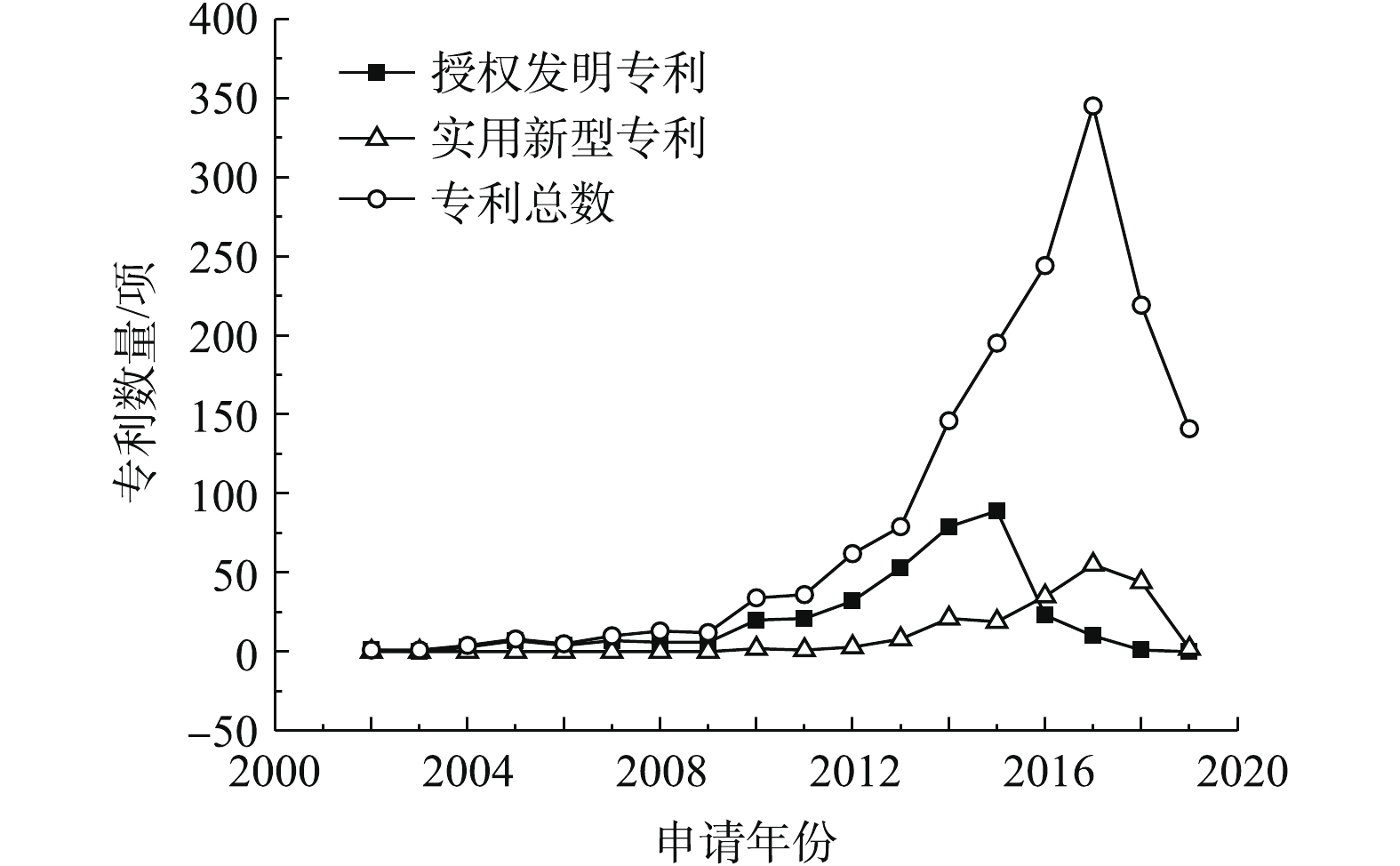
 下载:
下载:
